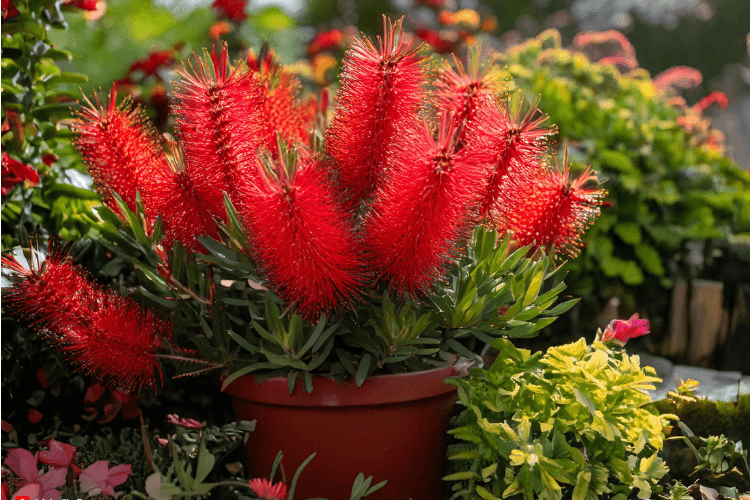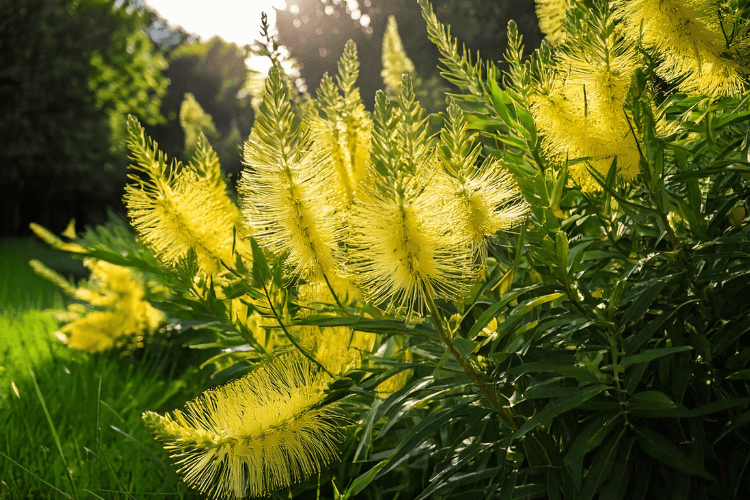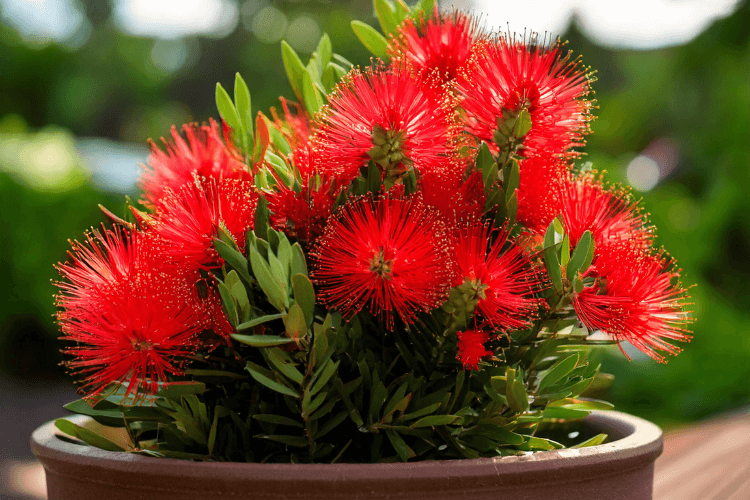If you’re looking to infuse your garden with vibrant color and attract local wildlife, the Bottle Brush Plant (Callistemon) is the perfect choice. With its unique, bottlebrush-shaped flowers in bright reds, yellows, and pinks, this Australian native offers a spectacular display throughout the year. Not only is the Callistemon a showstopper, but it also attracts pollinators like bees, birds, and butterflies, making it an ideal addition to any garden or landscape.
In this article, we’ll explore everything you need to know about the Bottle Brush Plant, from its varieties to care tips, planting, propagation, and troubleshooting common issues. By the end, you’ll be ready to introduce this vibrant plant into your garden and enjoy its many benefits.
Table of Contents
What Makes the Bottle Brush Plant Special?
Before diving into the specifics of care and planting, let’s first understand what a Bottle Brush Plant actually is. Named after its distinctive, bottle-brush-shaped flowers, this plant belongs to the Callistemon genus, native to Australia. However, it’s become a popular addition to gardens worldwide due to its vibrant blooms and ease of care.
The BottleBrush Plant can vary greatly depending on the species. You might find them as large shrubs or small trees, with flower colors ranging from bright reds to oranges and even yellow. Their unique, cylindrical flowers resemble the bristles of a bottle brush, making them a standout feature in any garden.
Types of Bottle Brush Plants for Your Garden
When selecting a BottleBrush Plant for your garden, you have several varieties to choose from. Each offers its own unique features, whether you’re looking for a plant with a larger, more dramatic display or one that’s more compact for smaller spaces.
Crimson Bottlebrush: The Bold Red Wonder

The Crimson Bottlebrush is one of the most popular varieties, known for its striking red flowers that resemble a traditional bottlebrush. This variety is a favorite for attracting hummingbirds and other pollinators. It’s a fast-growing, drought-tolerant plant that thrives in full sunlight, reaching heights of up to 10 feet, so it’s perfect for larger gardens or as a standout feature in your landscape.
- Flower Color: Bright red
- Height: 6 to 10 feet
- Best For: Attracting hummingbirds and adding a bold splash of color to your garden.
Dwarf Bottlebrush: Compact and Colorful

If you’re limited on space or prefer a more compact plant, the Dwarf Bottlebrush (Callistemon ‘Little John’) is an excellent choice. This variety stays much smaller, usually around 3-4 feet in height, and can even be grown in containers. Its compact nature makes it perfect for smaller gardens, patios, or as a focal point in your landscape design.
- Flower Color: Red or pink
- Height: 3 to 4 feet
- Best For: Smaller gardens, pots, and containers.
Weeping Bottlebrush: Cascading Beauty

For a dramatic effect, the Weeping Bottlebrush (Callistemon viminalis) is the perfect variety. As its name suggests, this plant has long, arching branches that droop elegantly, making it an excellent choice for cascading over walls, fences, or raised planters. It produces vibrant red flowers, and its weeping form gives it a distinctive, graceful appearance.
- Flower Color: Red or pink
- Height: 6 to 8 feet (depending on pruning)
- Best For: Hanging baskets, large ornamental plantings, and creating a cascading effect in your landscape.
Bottlebrush Citrinus: A Touch of Yellow

Another fantastic variety is Bottlebrush Citrinus, known for its aromatic leaves and soft yellow flowers. This variety works well in hedges, borders, or as an ornamental shrub. Its pleasant fragrance adds a sensory element to your garden, while the unique yellow flowers brighten up your landscape in a more subdued way than the typical red or pink varieties.
- Flower Color: Pale yellow
- Height: 6 to 8 feet
- Best For: Warm climates and providing a sunny, cheerful addition to your garden.
Little John Bottlebrush: Low-Growing and Versatile

The Little John Bottlebrush is another dwarf variety, known for its low-growing nature and compact size. Reaching only about 2 to 3 feet tall, it’s perfect for borders, containers, or as ground cover. Despite its small stature, it produces bold red or pink flowers that add plenty of visual interest.
- Flower Color: Red or pink
- Height: 2 to 3 feet
- Best For: Low-growing borders, containers, and ground cover.
How to Grow a Thriving Bottle Brush Plant
Growing a Bottle Brush Plant in your garden doesn’t require a green thumb, but there are a few key factors to ensure its success. Let’s walk through everything you need to know about planting, watering, and caring for this beautiful plant.
Choosing the Right Location
For your Bottle Brush Plant to flourish, selecting the right location is crucial. These plants thrive in full sunlight, so choose a spot that receives at least 6 hours of direct sunlight each day. Well-draining soil is also a must to prevent root rot. Avoid areas where water tends to pool, as the roots need to stay dry to maintain health.
- Pro Tip: Plant your BottleBrush Plant near pathways, fences, or other hardscape features where its striking flowers can be enjoyed up close.
Planting Guide
- Digging the Hole: The planting hole should be twice as wide as the root ball but no deeper.
- Placing the Plant: Gently remove the plant from its container and position it in the hole.
- Backfilling: Fill the hole with soil, pressing gently to remove any air pockets.
- Watering: Water the plant thoroughly after planting.
Watering and Fertilization
BottleBrush Plants are drought-tolerant once established, but they will need regular watering during their first few months in the garden. During the growing season, water deeply every week. However, be mindful not to overwater, as these plants prefer dry conditions once their roots are developed.
Fertilize the plant in early spring using a balanced fertilizer to promote healthy growth and abundant blooms.
How to Care for Your Bottle Brush Plant
Caring for your Bottle Brush Plant is relatively simple. With the right conditions, these plants can thrive with minimal effort. Here’s a guide to ensure your plant grows strong and healthy:
Pruning Tips
Pruning your BottleBrush Plant will help it maintain a neat, compact shape while encouraging more prolific blooming. The best time to prune is after the flowering season when the plant is dormant.
- Steps for Pruning:
- Remove dead or damaged branches.
- Trim back any long or unruly stems.
- Shape the plant to encourage even growth.
Seasonal Care
In colder climates, consider mulching around the base of your Bottle Brush Plant to protect the roots during the winter. In warmer climates, these plants need little protection, though a bit of shade during extreme heat can be beneficial.
Common Problems with Bottle Brush Plants and How to Solve Them
While the BottleBrush Plant is generally low-maintenance, it may face occasional challenges. Here are some common problems and solutions:
1. Yellowing Leaves
Yellowing leaves may signal problems such as overwatering, inadequate drainage, or a lack of essential nutrients. To solve this:
- Ensure proper soil drainage and be careful not to overwater the plant.
- Use a balanced fertilizer to supply essential nutrients for healthy growth
2. Lack of Blooms
If your Bottle Brush Plant isn’t blooming, it may not be getting enough sunlight. Make sure it’s planted in a sunny location. Pruning too much or too early can also remove buds, so be sure to trim after blooming.
3. Root Rot
Waterlogged soil can lead to root rot, a frequent problem for this plant. If you notice wilting, yellowing leaves, or a foul smell, check the roots for signs of rot. If the roots are mushy and brown, prune them back and replant in well-draining soil.
Landscaping Ideas with Bottle Brush Plants
Whether you’re designing a garden from scratch or adding a few new elements to your existing landscape, the Bottle Brush Plant can serve as an eye-catching focal point. Its vibrant blooms pair beautifully with other shrubs and flowers, creating a dynamic and colorful garden.
- Tips for Landscaping:
- Use BottleBrush Plants as hedges or screening plants.
- Combine them with ornamental grasses or flowering perennials to create texture and contrast.
- Plant them near patios or seating areas to enjoy their beauty up close.
Frequently Asked Questions (FAQ)
Q: Is the Bottle Brush Plant suitable for small spaces?
A: Yes! Varieties like the Little John Bottlebrush and Dwarf Bottlebrush are perfect for small gardens or containers. These smaller varieties require less space while still providing vibrant flowers and aesthetic appeal.
Q: How often should I water my Callistemon?
A: While Callistemon are drought-tolerant once established, you should water them regularly during their first growing season. After that, they only need deep watering every week or so, depending on the climate.
Q: Can the Bottle Brush Plant tolerate cold climates?
A: Bottle Brush Plants prefer warm climates but can tolerate some cold if protected during the winter months. Consider mulching around the base or bringing potted plants indoors during frosty spells.
Q: Are BottleBrush Plants good for attracting wildlife?
A: Yes, they attract hummingbirds, bees, and butterflies, making them an excellent choice for pollinator gardens.
.Q: How do I encourage more blooms on my BottleBrush Plant?
A: Ensure the plant gets plenty of sunlight, prune it after flowering, and use a balanced fertilizer that encourages blooms. Avoid overwatering, as this can hinder flower production.
Conclusion: Why You Should Add a Bottle Brush Plant to Your Garden
Whether you’re looking for a way to attract pollinators, add some color to your garden, or just appreciate the beauty of nature, the Bottle Brush Plant is a perfect choice. Its stunning flowers and easy care make it an ideal addition to any landscape, from small patios to large estates. Don’t wait—add this vibrant plant to your garden today and watch it transform your outdoor space into a vibrant paradise
Dive into our extensive plant care guides and let Plant Smile help you bring your garden dreams to life. With expert advice, practical tips, and the latest articles, you’ll be equipped to create a flourishing, breathtaking garden that thrives year-round. Don’t miss out—start your gardening journey with us today!

